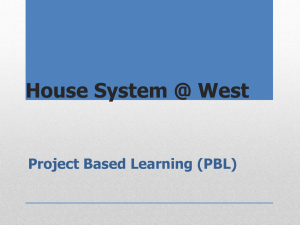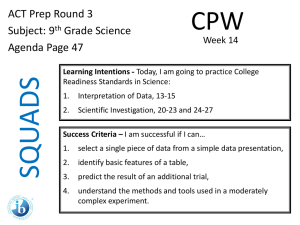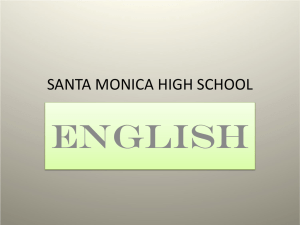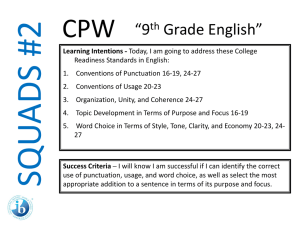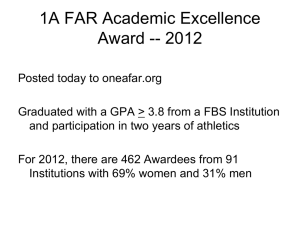Poster_starck_a 42_StarckPosterProject
advertisement
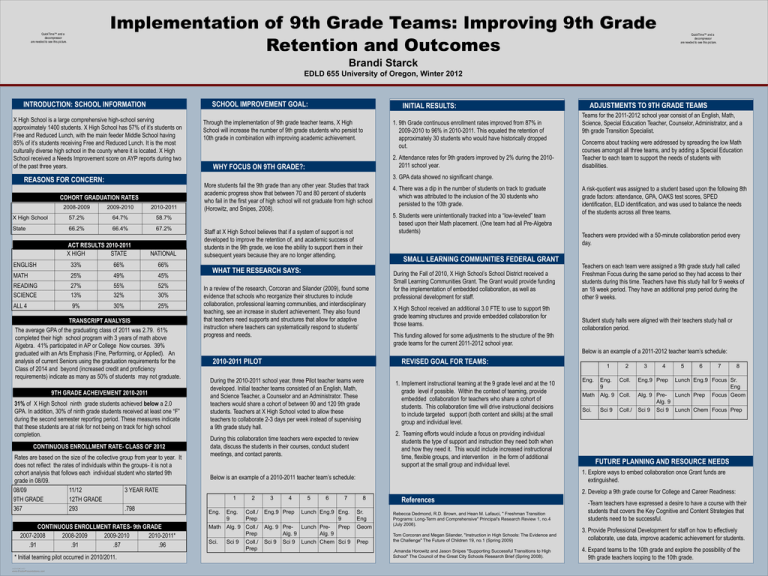
Implementation of 9th Grade Teams: Improving 9th Grade Retention and Outcomes QuickTime™ and a decompressor are needed to see this picture. QuickTime™ and a decompressor are needed to see this picture. Brandi Starck EDLD 655 University of Oregon, Winter 2012 SCHOOL IMPROVEMENT GOAL: INTRODUCTION: SCHOOL INFORMATION X High School is a large comprehensive high-school serving approximately 1400 students. X High School has 57% of it’s students on Free and Reduced Lunch, with the main feeder Middle School having 85% of it’s students receiving Free and Reduced Lunch. It is the most culturally diverse high school in the county where it is located. X High School received a Needs Improvement score on AYP reports during two of the past three years. COHORT GRADUATION RATES 2008-2009 2009-2010 2010-2011 X High School 57.2% 64.7% 58.7% State 66.2% 66.4% 67.2% ACT RESULTS 2010-2011 X HIGH STATE NATIONAL ENGLISH 33% 66% 66% MATH 25% 49% 45% READING SCIENCE 27% 13% 55% 32% 52% 30% ALL 4 9% 30% 25% TRANSCRIPT ANALYSIS The average GPA of the graduating class of 2011 was 2.79. 61% completed their high school program with 3 years of math above Algebra. 41% participated in AP or College Now courses. 39% graduated with an Arts Emphasis (Fine, Performing, or Applied). An analysis of current Seniors using the graduation requirements for the Class of 2014 and beyond (increased credit and proficiency requirements) indicate as many as 50% of students may not graduate. 9TH GRADE ACHEIVEMENT 2010-2011 31% of X High School ninth grade students achieved below a 2.0 GPA. In addition, 30% of ninth grade students received at least one “F” during the second semester reporting period. These measures indicate that these students are at risk for not being on track for high school completion. CONTINUOUS ENROLLMENT RATE- CLASS OF 2012 Rates are based on the size of the collective group from year to year. It does not reflect the rates of individuals within the groups- it is not a cohort analysis that follows each individual student who started 9th grade in 08/09. 08/09 11/12 3 YEAR RATE 9TH GRADE 12TH GRADE 367 293 .798 CONTINUOUS ENROLLMENT RATES- 9th GRADE 2007-2008 2008-2009 2009-2010 2010-2011* .91 .91 .87 .96 * Initial teaming pilot occurred in 2010/2011. www.PosterPresentations.com Through the implementation of 9th grade teacher teams, X High School will increase the number of 9th grade students who persist to 10th grade in combination with improving academic achievement. 1. 9th Grade continuous enrollment rates improved from 87% in 2009-2010 to 96% in 2010-2011. This equaled the retention of approximately 30 students who would have historically dropped out. 2. Attendance rates for 9th graders improved by 2% during the 20102011 school year. WHY FOCUS ON 9TH GRADE?: ADJUSTMENTS TO 9TH GRADE TEAMS Teams for the 2011-2012 school year consist of an English, Math, Science, Special Education Teacher, Counselor, Administrator, and a 9th grade Transition Specialist. Concerns about tracking were addressed by spreading the low Math courses amongst all three teams, and by adding a Special Education Teacher to each team to support the needs of students with disabilities. 3. GPA data showed no significant change. REASONS FOR CONCERN: POSTER TEMPLATE BY: INITIAL RESULTS: More students fail the 9th grade than any other year. Studies that track academic progress show that between 70 and 80 percent of students who fail in the first year of high school will not graduate from high school (Horowitz, and Snipes, 2008). Staff at X High School believes that if a system of support is not developed to improve the retention of, and academic success of students in the 9th grade, we lose the ability to support them in their subsequent years because they are no longer attending. 4. There was a dip in the number of students on track to graduate which was attributed to the inclusion of the 30 students who persisted to the 10th grade. 5. Students were unintentionally tracked into a “low-leveled” team based upon their Math placement. (One team had all Pre-Algebra students) SMALL LEARNING COMMUNITIES FEDERAL GRANT WHAT THE RESEARCH SAYS: In a review of the research, Corcoran and Silander (2009), found some evidence that schools who reorganize their structures to include collaboration, professional learning communities, and interdisciplinary teaching, see an increase in student achievement. They also found that teachers need supports and structures that allow for adaptive instruction where teachers can systematically respond to students’ progress and needs. During the Fall of 2010, X High School’s School District received a Small Learning Communities Grant. The Grant would provide funding for the implementation of embedded collaboration, as well as professional development for staff. X High School received an additional 3.0 FTE to use to support 9th grade teaming structures and provide embedded collaboration for those teams. A risk-quotient was assigned to a student based upon the following 8th grade factors: attendance, GPA, OAKS test scores, SPED identification, ELD identification, and was used to balance the needs of the students across all three teams. Teachers were provided with a 50-minute collaboration period every day. Teachers on each team were assigned a 9th grade study hall called Freshman Focus during the same period so they had access to their students during this time. Teachers have this study hall for 9 weeks of an 18 week period. They have an additional prep period during the other 9 weeks. Student study halls were aligned with their teachers study hall or collaboration period. This funding allowed for some adjustments to the structure of the 9th grade teams for the current 2011-2012 school year. Below is an example of a 2011-2012 teacher team’s schedule: 2010-2011 PILOT REVISED GOAL FOR TEAMS: During the 2010-2011 school year, three Pilot teacher teams were developed. Initial teacher teams consisted of an English, Math, and Science Teacher, a Counselor and an Administrator. These teachers would share a cohort of between 90 and 120 9th grade students. Teachers at X High School voted to allow these teachers to collaborate 2-3 days per week instead of supervising a 9th grade study hall. During this collaboration time teachers were expected to review data, discuss the students in their courses, conduct student meetings, and contact parents. 1. Implement instructional teaming at the 9 grade level and at the 10 grade level if possible. Within the context of teaming, provide embedded collaboration for teachers who share a cohort of students. This collaboration time will drive instructional decisions to include targeted support (both content and skills) at the small group and individual level. 2. Teaming efforts would include a focus on providing individual students the type of support and instruction they need both when and how they need it. This would include increased instructional time, flexible groups, and intervention in the form of additional support at the small group and individual level. 1 2 Eng. Coll. 9 Math Alg. 9 Coll. 3 4 5 6 7 8 Eng. Eng.9 Prep Sci. Alg. 9 PreAlg. 9 Sci 9 Sci 9 Lunch Chem Focus Prep Sci 9 Coll./ Lunch Eng.9 Focus Sr. Eng Lunch Prep Focus Geom FUTURE PLANNING AND RESOURCE NEEDS 1. Explore ways to embed collaboration once Grant funds are extinguished. Below is an example of a 2010-2011 teacher team’s schedule: 2. Develop a 9th grade course for College and Career Readiness: 1 Eng. 2 Eng. Coll./ 9 Prep Math Alg. 9 Coll./ Prep Sci. Sci 9 Coll./ Prep 3 4 Eng.9 Prep 5 6 7 Lunch Eng.9 Eng. 9 Alg. 9 Pre- Lunch Pre- Prep Alg. 9 Alg. 9 Sci 9 Sci 9 Lunch Chem Sci 9 8 Sr. Eng Geom Prep References Rebecca Dedmond, R.D. Brown, and Hean M. Lafauci, " Freshman Transition Programs: Long-Term and Comprehensive" Principal's Research Review 1, no.4 (July 2006). -Team teachers have expressed a desire to have a course with their students that covers the Key Cognitive and Content Strategies that students need to be successful. Tom Corcoran and Megan Silander, "Instruction in High Schools: The Evidence and the Challenge" The Future of Children 19, no.1 (Spring 2009) 3. Provide Professional Development for staff on how to effectively collaborate, use data, improve academic achievement for students. .Amanda Horowitz and Jason Snipes "Supporting Successful Transitions to High School" The Council of the Great City Schools Research Brief (Spring 2008). 4. Expand teams to the 10th grade and explore the possibility of the 9th grade teachers looping to the 10th grade.
